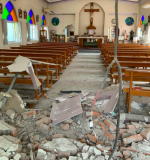By M L Satyan
Coimbatore, June 24, 2024: The terrible heatwave spread across India has been bothering me for a while as I too have experienced it in March-April this year. Here are some interviews by media:
Interview-1: Bicycle rickshaw driver Sagar Mandal of New Delhi told CNN on June 20 that he has been getting fewer passengers because people opt for air-conditioned taxis over open-air transport.
“My body can’t take it, but I have to keep cycling. We are used to physical labour. We are not complaining about that. But this heat is not normal, something has to change,” said the 39-year-old, who pedals people around the city. With a sad tone he further said, “No one cares if we live or die, no matter who you vote for. This is a problem no one wants to solve.”
Interview-2: Nikhil Kumar, an auto-rickshaw driver said his workdays are getting longer and tougher amid the heat. “It doesn’t get any better at night, even at night I am sweating. It rained a little last night but look how hot it is today, there is no relief,” the 26-year-old driver said.
Interview-3: “We have been living in this neighborhood for 40 years, but we have never seen a summer like this,” said 60-year-old Kalyani Saha, a resident of the Lajpat Nagar area of the national capital.
“There hasn’t been power for the last two hours, in the middle of the day that’s unbearable,” Saha told CNN, saying that power cuts also render their air-conditioning system useless. Further she said, “We get water only once a day, and it is scalding hot, unless you fill up a bucket and let it cool off all day before using it. You can’t bathe in this water.”
Interview-4: An official in the Ministry of Health told CNN, “At least 40,000 cases of heat stroke have been reported in India since March, and at least 110 people have died across the country due to suspected heat stroke as well.”
Interview-5: A staff from the NGO – Centre for Health Development India – said, “Between June 11 and 19, Delhi saw 192 heatwave-related deaths among its homeless population, a record high compared with the same period in the last five years.”
Climate change, predominantly caused by burning fossil fuels and exacerbated by human interference, is making heatwaves hotter and more likely to happen everywhere in the world. India is being hit by one of its worst heatwaves streaks ever, with many parts of the country experiencing consistent temperatures of over 50ºC.
Extreme heat forced schools to close early for the summer in India. Temperatures in at least 37 cities exceeded 45ºC, with warnings of a “very high likelihood” of heat illnesses for the entire population. Night-time temperatures remained as high as 36ºC in some locations, which is particularly dangerous as it means people cannot cool off at night. The number of heat stroke cases is likely a huge underestimate.
Heat in India and South Asia is characterised by being extremely humid, which makes it more dangerous for human health. High humidity levels prevent the body from cooling itself through sweating, raising the risk of heat strokes and other life-threatening conditions. The combination of intense heat and humidity poses life-threatening risks to the population, exposing them to conditions that exceed human tolerance.
I give some excerpts from an article by Sibu Kumar Tripathi published in India Today, on May 30, 2024. “Dr. Krishna Achuta Rao, Professor and Dean, Centre for Atmospheric Sciences, Indian Institute of Technology, Delhi, says, “The widespread, long-lasting, and intense heatwave conditions over India and many other parts of the world are the direct result of climate change caused by human emissions of greenhouse gases. There is an urgent need to take adaptation steps to control the rising global average temperatures; else, the result is in front of us.”
“Aarti Khosla, Director, Climate Trends, says, “Heatwaves are clearly the single largest threat to India’s well-being today. Record-breaking heat of over 48ºC across north, west, and central India shows that the climate crisis is a nice-to-push rhetoric as long as one has not experienced a 50ºC heatwave. As more and more Indian cities develop faster, climate resilience needs to be incorporated immediately to reduce the compounding impacts of extreme heat on human health, the economy, and livelihoods.”
“Aditya Valiathan Pillai, Fellow, Sustainable Futures Collaborative, says, “Delhi’s sustained high temperatures nearing the 50s bring the focus back on its Heat Action Plan. In this infernal heat, millions of heat-exposed workers without access to cooling will struggle to earn their wages, protect their families, and stay safe. Heatwave preparedness and response measures in Delhi’s newly minted Heat Action Plan must be implemented immediately.”
India’s domestic policy on climate and environmental action includes protecting regional glaciers, greening the railway system, reducing single-use plastic and producing clean cooking fuel etc. Are they implemented? The government’s response is known by the below interviews.
Prime Minister Narendra Modi was interviewed by school students sometime back. Answering to a student’s question on climate change he replied, “The people of 70, 80, 85 or 90 years of age used to say in winter that it is colder this year than ever before. Actually, it is not any colder. Their capacity to tolerate cold has reduced due to aging. In the same manner, the climate has not changed. We have changed.”
A few days ago, a reporter asked Jyotiraditya Scindia about the heatwave. He took an onion from his kurta pocket and said, “You must always remember Mausumi, that you do not have to worry about the heat as long as you have this onion.”
I leave it to the readers to decide whether the Prime Minister and the Minister of Communications gave the right and responsible answers.
It is important for our political leaders to take responsibility and show accountability that climate change is a real threat to our country. Unless we accept it, there will not be any solution. Also, as responsible citizens, we need to get into a lot of awareness-building activities and initiate appropriate climate emergency activities.









Increasing Heat wave is indeed a matter of grave concern for India especially for the rural India where ,more than 75% of the population resides. This year a certain part of Delhi recorded 52 degree Celsius plus which the authorities tried to play down as an error in the weather recording appatatus. Kolkata crossed 45 degrees and it felt like 50 degree Celsius. Though Monsoon has entered Bengal, except Sikkim and North Bengal where it has been raining cats and dogs, there has been hardly any rain in South Bengal, and other parts, including Kolkata.
Regarding the Church’s response to Pope Francis’ encyclical Laudato Si (on caring for our common home — planet earth), Church-run institutions have made a mockery of the encyclical. Jesuits-run St Xavier’s College (SXC) Kolkata cut down several decades-old large neem trees to make room for additional college complex. As a tokenism, it has planted a few saplings though! St Xavier’s university in Kolkata is fully air-conditioned. Hasn’t this policy warmed the outside air and worsened the heat wave? Several other church-run institutions too have followed or preceded the SXC way. The two church-run city schools which maintain good green cover, are St Lawrence High School and Loreto Entally School, Kolkata.
Also the cumulative effect of refrigerators, air-conditioners, computers, laptops, mobiles, filling up of water bodies to make way for real estate – all these are escalating the Climate Crisis. Yes it is no more Climate Change but Climate Crisis because but the effect of Global Warming is not restricted to one country but impacts across nations as Covid did. Global Warming is not as simplistic as the response of our PM and the union minister for communications on the issue.
The author would have done well to explain the two terms “climate resilience” and Delhi’s “Heat Action Plan” and how to go about them.